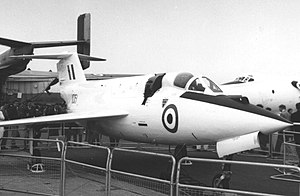SR.53
| SR.53 | |
|---|---|
 |
|
| The second SR.53 on display at the September 1957 Farnborough Air Show | |
| Role | Interceptor |
| Manufacturer | Saunders-Roe |
| Designer | Maurice Brennan |
| First flight | 16 May 1957 |
| Status | Experimental |
| Primary user | United Kingdom |
| Number built | 2 |
| Variants | Saunders-Roe SR.177 |
The Saunders-Roe SR.53 was a British prototype interceptor aircraft of mixed jet and rocket propulsion developed for the Royal Air Force (RAF) by Saunders-Roe in the early 1950s. As envisaged, the SR.53 would have been used as an interceptor aircraft, using its rocket propulsion to rapidly climb and approach incoming hostile bombers at high speeds; following its attack run, the aircraft would be able to return to its base by making use of the secondary jet propulsion instead.
Although the SR.53 proved to have promising performance during test flights, the requirement for such an aircraft had been overtaken by rapid advances in surface-to-air missile technology, leading to reconsideration of the aircraft's purpose. In July 1960, the development programme was formally cancelled, by which time a total of 56 test flights had been performed. A pair of prototype SR.53 aircraft had been completed and used during flight tests. One of these was destroyed during one such test flight in June 1958. The other, the first prototype, survived and was preserved; it is currently on public display at the Royal Air Force Museum Cosford.
The Second World War had demonstrated the importance of strategic bombing to modern warfare, and as the emerging Cold War developed, the development of new and more effective air defences against large waves of hostile bomber aircraft armed with nuclear weapons became a priority for many nations. During the war, Nazi Germany had extensively developed its own rocket-powered aircraft to augment its interception capabilities, in the final two years of the war, it had been able to deploy aircraft such as the Messerschmitt Me 163 and Bachem Ba 349 which, via rocket propulsion, had been capable of unparalleled rates-of-climb, enabling them to (at least in theory) rapidly sortie to intercept enemy bombers before they reached their targets. As the performance of these aircraft had become increasingly well known to the Allies, RAF experts were eager to explore and understand the underlying technology.
...
Wikipedia
